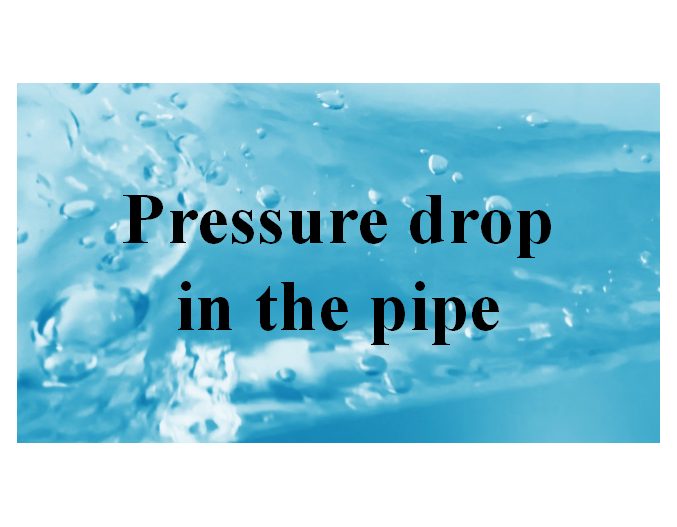Outline
The height at which a certain amount of liquid is pumped is called the head.
When transporting a liquid from top to bottom, gravity can make it fall as it is. However, when transporting from the bottom to the top, it is necessary to pump the liquid by adding energy.
On the other hand, simply adding energy equivalent to the height of the liquid to be pumped will not pump the liquid to that height.
This is because energy loss due to friction occurs in the flow path through which the fluid passes, and there is not enough energy along the way.
Or, if the outlet pressure at the point where the liquid is pumped is high, the liquid is held down, requiring extra energy.
Therefore, in addition to the energy required for the height to be pumped (actual head), energy loss due to friction and the difference in inlet and outlet pressure must be added.
The sum of all these energies, expressed as the pump head, is called the total head.
The calculation of the total head of a pump is a fundamental but very important calculation in fluid mechanics.
This article introduces the calculation of the total head of a pump.
How to calculate the total head of a pump
Basic equation for calculation of total head
The basic equation used in calculating the total head of a pump is Bernoulli's principle.
Bernoulli's principle is explained in detail in the article below.
-

Bernoulli's principle:Basic formula for pump head calculation
The energy conservation law for fluids is called Bernoulli's principle in particular. Thanks to Bernoulli's principle, engineers can calculate how much energy and pump lift is needed to lift a fluid to a given height.
続きを見る
First, from Bernoulli's principle, the basic equation applied to a real fluid is Eq. (1):
$$H=\frac{v_{2}^{2}-v_{1}^{2}}{2g}+H_{a}+\frac{P_{2}-P_{1}}{ρg}+h_{f}+h_{l}・・・(1)$$
where H is the total head, v1, v2 are the inlet and outlet velocity, g is the acceleration of gravity, Ha is the actual head, P1, P2 are the inlet and outlet pressure, ρ is the fluid viscosity, hf is the friction loss hydraulic head, hl is the shape loss hydraulic head.
Each term on the right-hand side is referred to as:
$$velocity\; head:\frac{v_{2}^{2}-v_{1}^{2}}{2g}$$
$$actual\; head:H_{a}$$
$$pressure\; head:\frac{P_{2}-P_{1}}{ρg}$$
$$friction\; loss\; hydraulic\; head:h_{f}$$
$$shape\; loss\; hydraulic\; head:h_{l}$$
The total head H of the pump can be calculated by adding all five of these terms together.
In this article, we will calculate the following piping system as an example.

fluid density:1,000kg/m3
mass flow:30,000kg/h
Pressure in suction side equipment:0.2MPaG
Pressure in the discharge side equipment:0.4MPaG
Suction side tank I.D.:4m
Suction side pipe I.D.:80mm
DIscharge side pipe I.D.:100mm
Straight pipe length on suction side:25m
Straight pipe length on discharge side:30m
Friction loss in piping: f=0.004
shape loss:90° elbow×2、Globe valve×1(opening fully)
Velocity head
The velocity head is calculated from the flow rate through the piping, the tank inner diameter, and the pipe inner diameter.
$$v_{1}=\frac{30000}{1000×3600×(\frac{4}{2})^{2}π}≒6.63×10^{-4}m/s$$
$$v_{2}=\frac{30000}{1000×3600×(\frac{0.1}{2})^{2}π}≒1.06m/s$$
$$\frac{v_{2}^{2}-v_{1}^{2}}{2g}=\frac{1.06^{2}-(6.63×10^{-4})^{2}}{2×9.8}=0.057m・・・(2)$$
Actual head
Actual head is the difference in height between the suction and discharge positions.
In this example, the suction position is higher than the installation position of the pump, so the following formula is used.
$$H_{a}=z_{2}-z_{1}=9-4=5m・・・(3)$$
Pressure head
The pressure hydraulic head is calculated from the difference in static pressure at the inlet and outlet.
The most obvious example is when both inlet and outlet liquids are open to the atmosphere.
Since P1 = P2 = atmospheric pressure, the pressure hydraulic head is zero.
In this case, the static pressure in each equipment is the calculation condition.
$$\frac{P_{2}-P_{1}}{ρg}=\frac{(0.4-0.2)×10^{6}}{1000×9.8}≒20.408m・・・(4)$$
The head required for the pressure head is larger than the actual head in this example.
Be aware that a large head is required when the pressure on the discharge side is high.
Friction loss hydraulic head
Friction loss hydraulic head refers to the pressure loss in a straight pipe and can be calculated using Fanning's equation.
Fanning's equation is explained in detail in the article below.
-

Fanning's equation:Pressure drop in piping
Fanning's equation is used to calculate the pressure drop in a straight pipe when calculating the pump head. If the pump head is determined only by the actual head without considering the pressure drop in Fanning's equation, the pump will not be able to transfer the fluid to the desired location because of the loss of energy due to friction between the fluid and the piping.
続きを見る
Eq. (5) is Fanning's equation:
$$h_{f}=4f\frac{u^{2}}{2g}\frac{L}{d}・・・(5)$$
where f is the coefficient of friction, u is the fluid velocity, L is the pipe length, d is the pipe diameter.
If the pipe diameter does not change between the suction and discharge piping, it is easier to calculate them together.
In this case, the piping diameters are different, so they are calculated separately.
$$h_{f1}=4×0.004×\frac{1.658^{2}}{2×9.8}\frac{25}{0.08}≒0.701m・・・(6)$$
$$h_{f2}=4×0.004×\frac{1.061^{2}}{2×9.8}\frac{30}{0.1}≒0.276m・・・(7)$$
hf1 is the friction loss hydraulic head at suction side, hf2 is the friction loss hydraulic head at discharge side.
Shape loss hydraulic head
Piping does not consist only of straight pipes; in fact, there are variously shaped flow paths with bends, expanding and contracting sections, and valves in between.
The shape loss hydraulic head hl is the value obtained by adding up all the loss hydraulic heads of such special shapes.
The shape loss hydraulic head hl is explained in detail in the article below.
-

How to calculate pressure drop in the pipe
When a fluid loses energy due to friction with a wall or between fluids, it is called pressure loss. In this article, we will introduce a calculation method for pressure loss in a piping flow path, which is frequently calculated in practice.
続きを見る
First, there are two 90° elbows, so we calculate the shape loss hydraulic head for these.
$$L_{e1}=n×d=32×0.08=2.56m$$
$$L_{e2}=n×d=32×0.1=3.20m$$
Le1 is the equivalent diameter of 90° elbow on suction side, Le1 is the equivalent diameter of 90° elbow on discharge side.
Therefore, the shape loss hydraulic head hl is expressed by the following equations.
$$h_{l1}=4×0.004×\frac{1.658^{2}}{2×9.8}\frac{2.56}{0.08}≒0.072m$$
$$h_{l2}=4×0.004×\frac{1.061^{2}}{2×9.8}\frac{3.2}{0.1}≒0.029m$$
hl1 is the shape loss hydraulic head at suction side elbow, hl2 is the shape loss hydraulic head at discharge side elbow.
Finally, the shape loss hydraulic head of the globe valve is calculated.
$$L_{e3}=n×d=300×0.1=30m$$
$$h_{l3}=4×0.004×\frac{1.061^{2}}{2×9.8}\frac{30}{0.1}≒0.276m$$
Le3 is the equivalent diameter of the glove valve, hl3 is the shape loss hydraulic head at the glove valve.
Total each head and calculate total head
Total each hydraulic head.
$$H=0.057+5+20.408+0.701+0.276+0.072+0.029+0.276≒26.8m$$
Once the total head is calculated, we can then look at the H-Q performance curve of the pump to see if the total head is sufficient for the flow rate we want to operate.
If it is not enough, that pump is not performing well enough, and the pump must be renewed.
We often leave the selection of pumps for new plant designs to the manufacturer. However, calculations are often done in-house to determine if the pump head is sufficient when increasing the flow rate for capacity expansion, etc.
In conclusion
The calculation method for the total head of a pump is explained.
It would be better to create a calculation formula once and then, from the next time onward, the calculation can be done simply by changing the input conditions.

